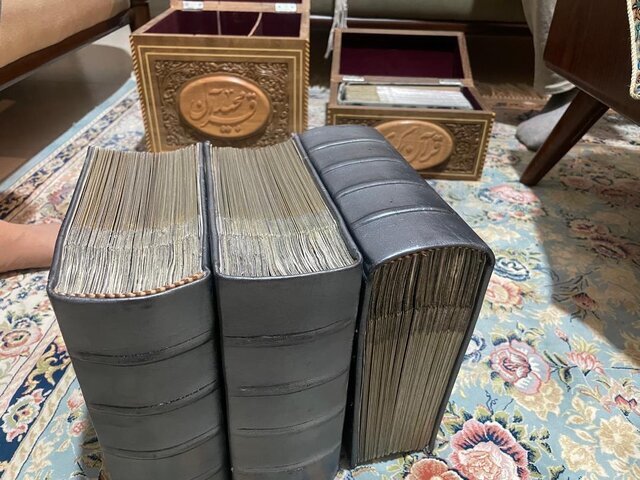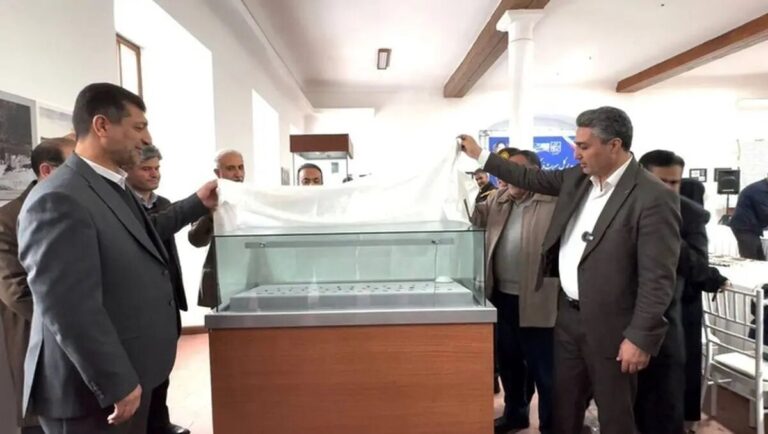
Similar Posts

Iranian Artist Unveils Stunning Metal-Engraved Quran Copies at Qatar Exhibition
Iranian artist Seifollah Mohammadpouram has unveiled four exquisite editions of the Holy Quran, intricately engraved on metal sheets in Qatar. These editions, varying in size and weight (3 kg, 8 kg, 12 kg, and 18 kg), showcase exceptional craftsmanship and a blend of traditional Islamic art with modern techniques. The 3 kg edition measures 10 x 15 cm, while the 18 kg version comprises three volumes. Each edition reflects the artist’s dedication to preserving cultural heritage and spirituality through art. This showcase highlights the importance of artistic expressions in connecting faith, culture, and community, leaving a lasting impact on viewers.

Exquisite Persian Carpets Adorn Pope’s Funeral: A Touch of Tradition and Elegance
The inclusion of Persian carpets in papal funeral rites, showcased during Pope Francis’s funeral at St. Peter’s Basilica, underscores the cultural exchanges between Islamic and Christian traditions. The vibrant carpets, originating from Iran, have been part of this ceremony for over six centuries, defining sacred spaces in Christian art and rituals. Notable examples include their depiction at the feet of significant figures, enhancing the holy atmosphere. Pope Francis’s simple wooden casket, situated on a Persian carpet, reflects his preference for modesty while retaining the tradition. This practice symbolizes the rich interplay of cultures and reverence for the sacred within the Catholic faith.

Celebrating 89 Years of Veresk: A Marvel of Engineering and Historical Significance
Veresk Bridge, an engineering marvel of the Trans-Iranian Railway, celebrates its 89th anniversary. Located in Veresk village, Iran, it was inaugurated on May 6, 1936, by Reza Shah Pahlavi, who addressed public concerns by having foreign engineers stand beneath it during the first train’s crossing. Standing at about 106 meters, with a 66-meter arch, the bridge was built by a diverse international workforce using primitive tools. It played a crucial role during WWII, earning the nickname “The Bridge of Victory.” In 2021, it was designated a UNESCO World Heritage site, symbolizing resilience and innovation in Iran’s transportation history.

Urmia Museum Unveils 55 Recovered Artifacts Smuggled from Türkiye: A Cultural Treasure Trove Restored
A special exhibition featuring 55 smuggled Iranian artifacts has opened at the Urmia Museum of Archaeology, celebrating the 46th anniversary of the Islamic Revolution. The items, recently returned from Türkiye, include a Sassanian sword, ancient figurines, glass bowls, a copper ewer, and 42 coins, highlighting Iran’s rich history. The event, attended by cultural officials and heritage experts, underscores the importance of protecting cultural heritage from illicit trafficking. This exhibition not only showcases Iran’s historical narrative but also emphasizes the need for global cooperation in preserving cultural artifacts for future generations.

Embracing Digital Diplomacy: A Game-Changer for Modern Diplomats and Ambassadors
In the evolving landscape of global tourism, soft power has become vital for attracting travelers. Tourism researcher Mohsen Sohani recently discussed the role of public diplomacy in an interview, emphasizing the importance of cultural engagement through social media. He pointed out how foreign ambassadors in Iran, like South Korea’s Kim Jun-pyo, engage with local traditions to foster connections. While many countries leverage social media for impactful narratives, Iranian diplomats have yet to embrace this approach, often relying on outdated methods. To enhance Iran’s global image and tourism appeal, a shift towards innovative public diplomacy is essential, utilizing digital platforms to build cultural bridges.

Stunning Discovery: Ancient Greek Tomb Unearthed Near Corinth Reveals Secrets of a Lost Civilization
The Ministry of Culture has announced the discovery of an ancient Greek tomb site near Tenea in Corinth, resembling Hellenistic Macedonian tombs. The site features a unique “T”-shaped layout with a corridor and a burial chamber, housing a well-preserved sarcophagus believed to contain an adult woman. Archaeologists found various artifacts, including a gold ring depicting Apollo, Hellenistic coins, and votive offerings, indicating the site’s historical and religious significance. The tomb, used until the 4th century AD, has been linked to burial practices and rituals. Ongoing excavations promise to unveil further insights into ancient Greek culture and traditions.